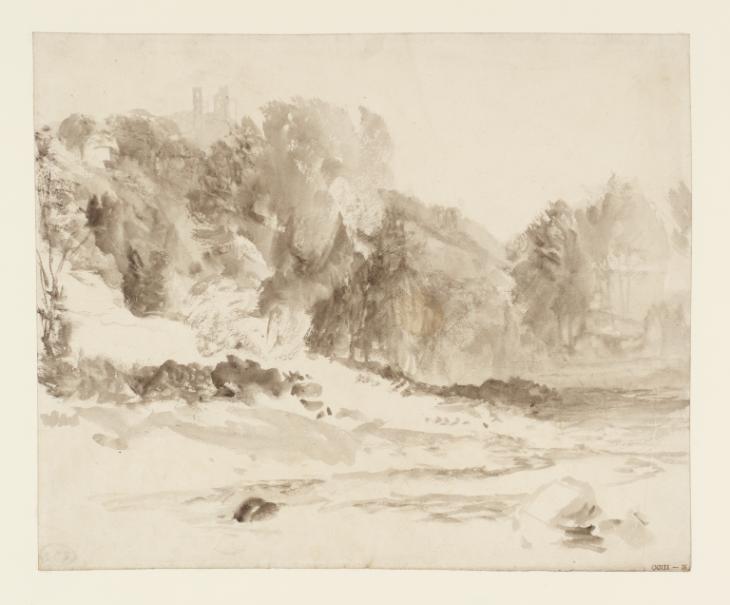Joseph Mallord William Turner Dob Park Lodge above the River Washburn ?1824
Joseph Mallord William Turner,
Dob Park Lodge above the River Washburn
?1824
Joseph Mallord William Turner 1775–1851
Dob Park Lodge above the River Washburn ?1824
D17771
Turner Bequest CCIII N
Turner Bequest CCIII N
Pencil and watercolour on white wove paper, 190 x 231 mm
Blind-stamped with Turner Bequest monogram towards bottom centre
Stamped in black ‘CCIII – N’ bottom right
Blind-stamped with Turner Bequest monogram towards bottom centre
Stamped in black ‘CCIII – N’ bottom right
Accepted by the nation as part of the Turner Bequest 1856
Exhibition history
1878
Oxford Loan Collection, University Galleries, Oxford 1878–1909 or later (138; renumbered 168, as ‘Junction of Greta and Tees, Mortham Tower. Sepia.’).
1980
Turner at the Bankside Gallery: Drawings & Water-colours of British River Scenes from the British Museum, Bankside Gallery, London, November–December 1980 (76, as ‘River Scene’, c.1830, reproduced).
2000
Pure as Italian Air: Turner and Claude Lorrain, Tate Britain, London, November 2000–April 2001 (no catalogue).
2002
Turner et le Lorrain, Musée des beaux-arts, Nancy, December 2002–March 2003 (57, as ‘Dob Park Castle, near Folly Hall, above the Washburn, Yorkshire’, c.1824, reproduced in colour).
References
1904
E.T. Cook and Alexander Wedderburn eds., Library Edition: The Works of John Ruskin: Volume XIII: Turner: The Harbours of England; Catalogues and Notes, London 1904, p.567 (Oxford loans catalogue, 1878) no.168, as ‘Junction of Greta and Tees, Mortham Tower. Sepia.’.
1909
A.J. Finberg, A Complete Inventory of the Drawings of the Turner Bequest, London 1909, vol.I, p.617, CCIII N, as ‘River scene (4)’.
1980
Michael Spender in Spender and Malcolm Fry, Turner at the Bankside Gallery: Catalogue of an Exhibition of Drawings & Water-colours of British River Scenes from the British Museum, exhibition catalogue, Bankside Gallery, London 1980, p.162 no.76, as ‘River Scene’, reproduced p.163.
1824
Ian Warrell in Warrell, Blandine Chavanne and Michael Kitson, Turner et le Lorrain, exhibition catalogue, Musée des beaux-arts, Nancy 2002, p.126 no.57, reproduced in colour, p.194, as ‘Dob Park Castle, near Folly Hall, above the Washburn, Yorkshire’, c.1824.
2014
Ian Warrell, ‘Joseph Mallord William Turner 1775–1851: The Farnley-Munro Sketchbook’ in Lowell Libson Ltd 2014, London 2014, p.92.
As recognised by Finberg in his sequencing,1 Tate D17768–D17772 (Turner Bequest CCIII K, L, M, N, O) form a group of similar wooded river valley subjects in pencil and wash. The present work is the only one firmly identified by Ian Warrell as a view on the River Washburn, between Folly Hall and the ruined Dob Park Lodge,2 but he has plausibly suggested that they all probably represent the river,3 not far up the valley north-west of Walter Fawkes’s home at Farnley Hall (see David Hill’s introduction to this section).
Warrell mentions these five sheets in passing in relation to the disbound ‘Munro’ or ‘Farnley-Munro’ sketchbook, in use on Turner’s last visit to Farnley in the late autumn of 1824, the year before Fawkes, his great friend and patron, died.4 He has suggested that the artist may have been encouraged in the creation of tonal, inky drawings here and in that slightly larger sketchbook5 by a knowledge of his former patron Richard Payne Knight’s6 album of wash studies by the French artist Claude Lorrain (c.1604–82), who was in any case an important influence.7 Knight acquired the album not long before his death in 1824, and left its contents to the British Museum, London.8 Both the Liber Studiorum and the so-called ‘Little Liber’ (see the relevant section of the present catalogue, c.1806–24 and c.1823–6) owe a debt to Claude – the former in its general concept, style and certain compositions, and the latter perhaps in its emphasis on chiaroscuro.9
Although any specific influence of the Payne Knight album on the present works will probably remain a matter for speculation, Warrell observes that during the 1824 Farnley visit Turner ‘worked predominantly in monochrome washes that resemble some of Claude’s broader effects’ the present work being among a group ‘clearly sketched fluently on the spot ... almost as if Turner was assimilating the meaning of Claude’s “bits” of nature to be found among the Payne Knight collection and putting into practice what they revealed.’10
There are pencil views on the Washburn possibly from as early as 1808 (Tate D12120, D12121; Turner Bequest CLIV V, W), and numerous later views include a finished watercolour showing Dob Park Lodge, On the Washburn, under Folly Hall (British Museum, London),11 based on a partly coloured drawing of about 1816 in the Large Farnley sketchbook (Tate D09057; Turner Bequest CXXVIII 41).
When the present drawing was exhibited in 1878, John Ruskin described it as ‘Junction of Greta and Tees, Mortham Tower’,12 apparently linking it to the watercolour Junction of the Greta and the Tees (currently untraced),13 engraved in 1834 for Walter Scott’s Poetical Works (Tate impression: T04955), to which it bears no more than a fortuitous general resemblance in its juxtaposition of tower, trees and river.14
See Warrell 2014, p.89, pp.89–93, and catalogue entries for selected pages from the sketchbook, ibid., pp.94–100; see also A.J. Finberg, ‘Turner’s Newly-Identified Yorkshire Sketchbook’, Connoisseur, October 1935, pp.185–7.
See Terry Riggs, ‘Knight, Richard Payne (1751–1824)’ in Evelyn Joll, Martin Butlin and Luke Herrmann (eds.), The Oxford Companion to J.M.W. Turner, Oxford 2001, pp.157–8.
See Warrell, Chavanne and Kitson 2002; and Ian Warrell and others, Turner Inspired: In the Light of Claude, exhibition catalogue, National Gallery, London 2012.
Technical notes:
There is an adventitious brown splash to the right of the centre.
Verso:
Blank; inscribed by ?John Ruskin in ink ‘232’ (circled) bottom right; inscribed in blue pencil ‘234’ at centre.
Matthew Imms
September 2016
How to cite
Matthew Imms, ‘Dob Park Lodge above the River Washburn ?1824 by Joseph Mallord William Turner’, catalogue entry, September 2016, in David Blayney Brown (ed.), J.M.W. Turner: Sketchbooks, Drawings and Watercolours, Tate Research Publication, December 2016, https://www

